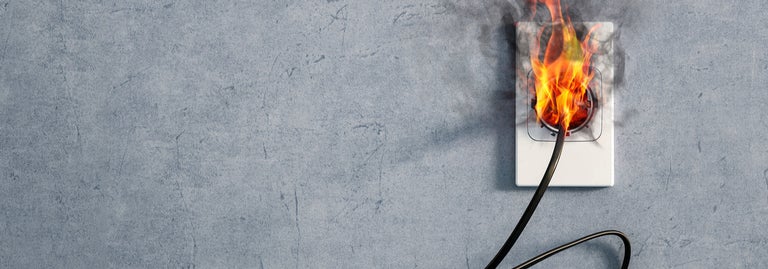Now that the clocks have gone back and the days are getting noticeably shorter, it’s a sure sign that colder weather on its way. But before winter sets in, it pays to do an annual pre-winter check, to ensure your home is fire safe for winter. Check out our five-step list:
How To Make Your House Fire Safe Before Winter. Our five step plan covers:
Step one: smoke alarm check
Worryingly, Fire and Emergency NZ stats reveal that only 60% of house fire callouts they attended last year in NZ had working smoke alarms. Check your smoke alarm’s batteries and ensure they are working. It could be a matter of life and death. Check your alarm’s expiry date, too, and that they’re installed correctly.
Step two: fireplace check
Make sure you check your chimney and sweep it ahead of winter. It’s an important step to reduce the chance of a house fire. Check your chimney and fireplace are in working order. And have a good stock of dry wood, as this limits the build-up of creosote inside your flu when it burns.
Have a look at your home and contents policy, too, as it may specify certain requirements you need to meet concerning your fireplace and chimney. Talk to your insurer if you have any questions.
Step three: test your heaters
Test your non-electric heaters for gas or carbon monoxide leaks, and make sure all electric heating appliances are free of dust and have cables and plugs that are undamaged. This should prevent any fire accidents.
While you’re at it, check any electric blankets you have are in good working condition, and consider installing timers to ensure they’re not accidentally left on. Heaters use more energy than standard appliances, so check they’re plugged into a wall socket only. Make sure they’re not overloading multi-boxes that could spark and cause a fire.

Heating can eat up significant power in winter, so it pays to check you’re on an electricity plan that best suits your home. When was the last time you reviewed how much you’re paying for your power? Electricity providers in NZ change their pricing and plans all the time to stay competitive. So if you’ve been with the same provider for yonks, chances are there is a far better value deal out there for your home. You could potentially save hundreds of dollars a year by switching to a more competitive plan.
Take a look at your next power bill. Once you know how much you’re paying in fixed and variable charges, it’s easy to jump online and compare different power companies and the deals they’re offering. A good place to start is Canstar’s most recent review of electricity providers, here is a snippet of our top scoring providers.
Canstar Blue’s NZ power company review
Our latest review of NZ power companies compares them on customer satisfaction and value for money. The table below is an abridged version of our full results.
^ By clicking on a brand or 'details' button, you will leave Canstar Blue and be taken to either a product provider website or a Canstar Blue NZ brand page. You agree that Canstar Blue NZ’s terms and conditions apply (without limitation) to your use of this service,to any referral to a product provider from our website, and any transaction that follows. Canstar Blue may earn a fee for referrals from its website tables, and from sponsorship (advertising) of certain products. Payment of sponsorship fees does not influence the star rating that Canstar Blue awards to a sponsored product. Fees payable by product providers for referrals and sponsorship may vary between providers, website position, and revenue model. Sponsorship fees may be higher than referral fees. Sponsored products are clearly disclosed as such on website pages. They may appear in a number of areas of the website such as in comparison tables, on hub pages and in articles. Sponsored products may be displayed in a fixed position in a table, regardless of the product’s rating, price or other attributes. The table position of a sponsored product does not indicate any ranking, rating or endorsement by Canstar Blue. See How we are funded for further details.
Canstar Blue NZ Research finalised in April 2023, published in June 2023.
See Our Ratings Methodology
For more information on sniffing out the best power deal, check out our story: Simple Guide to Finding the Cheapest Power Deals. And for the full result of our electricity Customer Satisfaction Award, just click on this big button:
Compare electricity providers for free with Canstar!
Step four: reduce risks outside
While checking for winter fire risks inside, it pays to also take the time to minimise the risk of anything going wrong on the outside of your home. The Insurance Council of NZ has a simple pre-winter checklist for landlords and homeowners:
- Check roofs and gutters to make sure they are well maintained and clear of debris and leaf litter
- Trim overhanging branches and remove dead or dying trees to reduce the likelihood of damage during storms
- Add drainage to pathways that collect puddles or may ice over
- Check the seals on windows, doors and roofs. Insurance doesn’t cover gradual damage so any existing or potential water leaks are best checked for and repaired regularly
- If you have an old hot water cylinder, consider having it checked by a plumber to ensure it’s functioning well and doesn’t need to be replaced. A ruptured hot water cylinder can cause a lot of damage and be expensive to recover from

Step five: be familiar with your insurance policy
When things do go awry, sometimes the shock can become compounded by an insurance claim being denied. If it’s been a while since you read the T&Cs of your home and contents insurance policy, take the time to reacquaint yourself with your level of cover. Be familiar with policy inclusions and exclusions. Most contents policies will often cover temporary accommodation costs – this includes renters contents policies.
Canstar’s latest research reveals only 41% of people regularly review the level of their home and contents cover. And a whopping 83% just renew annually with the same insurer. Don’t make this common mistake. Save money and get at least three online quotes. Compare home and contents insurance policies between providers, because there can be a significant difference in both price and features.

Play around with excesses, too. With online quoting, you can easily see which excess options make premiums cheaper. Weigh up the differences between higher premiums and lower excesses, and vice versa. You may be able to save on your premium by increasing your excess. If you don’t know what options are available, how will you know whether or not there’s a provider and policy that can work better for you?
If you are searching for a better deal on your home insurance, Canstar can help. We rate and compare a variety of insurers on our database, just hit the button below to compare them:
Compare home and contents insurance with Canstar
Enjoy reading this article?
You can like us on Facebook and get social, or sign up to receive more news like this straight to your inbox.
By subscribing you agree to the Canstar Privacy Policy


Share this article